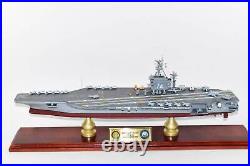
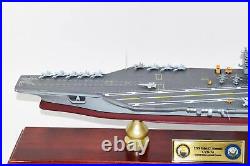
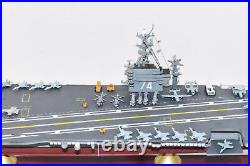
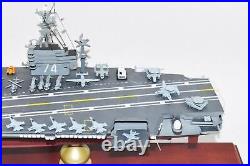
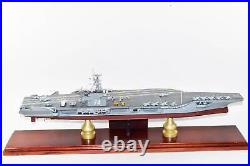
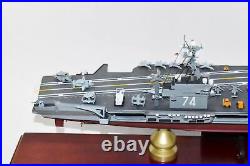

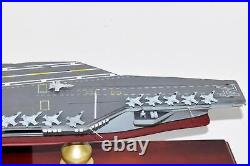
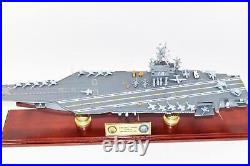
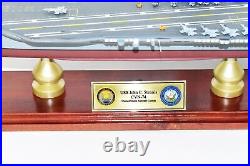

USS John C Stennis CVN-74 Nimitz Class Carrier Model, Navy, Mahogany, 24 inch, Nimitz Class. USS John C Stennis CVN-74 Nimitz Class Carrier Model. Fly off of the USS John C Stennis CVN-74 Nimitz Class Carrier Model in this handcrafted wooden model. Each model is carved from wood and handcrafted to provide a piece you’ll love. Length – 24 inches. US Veteran Owned Business. Stennis (CVN-74) is the seventh Nimitz-class nuclear-powered supercarrier in the United States Navy, named for Democratic Senator John C. She was commissioned on 9 December 1995. Her home port is temporarily Norfolk, Virginia, for her scheduled refueling complex and overhaul, which began in 2019. After her overhaul is completed sometime in the 2020s, she is scheduled to return to Bremerton, Washington. The mission of John C. Stennis and her air wing (CVW-9) is to conduct sustained combat air operations while forward-deployed. The embarked air wing consists of eight to nine squadrons. Attached aircraft are Navy and Marine Corps F/A-18 Hornet, EA-18G Growler, MH-60R, MH-60S, and E-2C Hawkeye. The air wing provides a visible presence to demonstrate American power and resolve in a crisis. Stennis’s two nuclear reactors give her virtually unlimited range and endurance and a top speed in excess of 30 knots (56 km/h, 34.5 mph). For defense, in addition to her air wing and accompanying vessels, John C. Stennis has NATO RIM-7 Sea Sparrow and Rolling Airframe Missile (RAM) surface-to-air missile systems, the Phalanx Close-in Weapons System for cruise missile defense, and the AN/SLQ-32 Electronic Warfare System. History The nuclear-powered USS John C. Stennis (CVN 74) was contracted on 29 March 1988, and the keel was laid on 13 March 1991 at Newport News Shipbuilding, Newport News, Virginia. Stennis was commissioned on 9 December 1995 at Naval Station Norfolk, Virginia, and she conducted flight deck certification in January 1996. The first arrested landing was by a VX-23 F-14B. Included among these events was the first carrier landing of an F/A-18E/F Super Hornet on 18 January 1997. On 26 February 1998 with Carrier Air Wing Seven embarked, John C. Stennis left Norfolk for her maiden deployment, transiting the Suez Canal on 7 March and arriving in the Persian Gulf on 11 March 1998. Stennis departed the Persian Gulf on 19 July 1998 for her new home port of Naval Air Station North Island in San Diego, California, arriving on 26 August 1998. In October 1998, she entered a six-month maintenance and upgrade period at North Island, returning to sea in April 1999. During the maintenance period, a jet blast deflector collapsed, severely injuring two sailors. [5] Silt clogged the intake pipes to the steam condensing systems for the nuclear reactor plants, causing the carrier’s two nuclear reactors to be shut down (one reactor by crew, the other automatically) for a period of 45 minutes. She was towed back to her pier for maintenance and observation for the next two days. 2000 On 7 January 2000, John C. Stennis deployed to the Persian Gulf to relieve USS John F. Kennedy in Operation Southern Watch. Following the September 11 attacks, John C. Stennis conducted Noble Eagle missions off the U. In 2000 and 2001, John C. Stennis was part of Carrier Group 7. Fifth Fleet area of responsibility in support of Operation Enduring Freedom, returning to San Diego on 28 May 2002. From June 2002 to January 2003, JCS underwent a seven-month Planned Incremental Availability (PIA). 2004 From 24 May to 1 November 2004, John C. Shortly after returning from deployment to San Diego, JCS changed her home port to Naval Station Bremerton, Washington on 19 January 2005. Once at Bremerton, John C. Stennis underwent an 11-month docking planned incremental availability (DPIA), the first time she had been dry-docked since commissioning. Upgrades included a new mast. The new mast’s structure is the first of its kind. A new type of steel alloy was uséd, making it stiffer and thicker than before. The new mast is also heavier and taller, allowing it to support new antennae the old mast would not have been able to support. Other upgrades included the installation of a new integrated bridge system in the pilothouse that will save manpower and provide state-of-the-art displays. [7][8][9][10]. On 20 January 2007, the carrier and her group set sail for the Persian Gulf as part of an increase in US military presence. Stennis arrived in the area on 19 February 2007, joining USS Dwight D. Eisenhower in the United States Fifth Fleet area of operations. [12] This marked the first time since 2003 that there were two aircraft carrier battle groups in the region simultaneously. On 23 May 2007, John C. US Navy officials said it was the largest such move since 2003. On 31 August 2007 John C. Stennis departed Bremerton for a 6-month deployment to the western Pacific on 13 January 2009. Burnham, was relieved by Rear Admiral Mark A. Vance over unspecified personal conduct. Burnham was reassigned to a base in San Diego, pending an investigation. After participating in exercises with Japan Maritime Self Defense Force and the Republic of Korea, as well as joint exercise Northern Edge 2009, John C. On 30 March 2011, a VMFAT-101 F/A-18C Hornet suffered an uncontained catastrophic engine failure, exploded and caught fire just before launch from John C. Stennis about 100 miles (160 km) off the coast of San Diego during launch and recovery training operations. The aircraft was at full power, in tension on the catapult when the accident occurred. Eleven flight deck crewmen were injured while the pilot was unhurt. There was no major damage to the carrier but the aircraft was a total loss. On 18 December 2011, the final command-and-control mission for U. Forces over Iraq was flown by an E-2C Hawkeye (pictured) from Carrier Airborne Early Warning Squadron 112 (VAW-112), catapulting off the carrier John C. M, both local time. This mission effectively ended U. Naval support for Operation New Dawn. 2012 On 3 January 2012, Iranian General Ataollah Salehi warned John C. Stennis not to return to the Persian Gulf. [20] The United States dismissed the warning. On 7 January, John C. Stennis led the rescue of an Iranian-flagged fishing vessel, Al Mulahi, following her seizure by pirates. Stennis dispatched a helicopter and cruiser to assist. A boarding party captured the pirates who attacked Sunshine, fed them, then released them temporarily. Crew from the destroyer USS Kidd then boarded the fishing vessel (upon permission in Urdu from the captain), and arrested all of the pirates with no casualties. On 2 March 2012, John C. On 7 July 2012, crew members were informed that John C. Stennis would be returning to the Middle East in August, much sooner than expected. On 27 August 2012, John C. Stennis departed to the Middle East originally for six months, but was extended to eight. Local ITE students were invited for a guided tour inside the aircraft carrier. At 12:45 on 3 May 2013, John C. Stennis arrived at her home port of Naval Base Kitsap in Bremerton, Washington, the completion of a ten-month, 66,000 miles (106,000 km) deployment to the western Pacific Ocean. During this deployment, squadron aircraft flew more than 1,300 sorties from the carrier’s deck in the war in Afghanistan. Stennis completed her Docking Planned Incremental Availability (DPIA) on 5 November 2014. 2015 In mid-January 2015, John C. Stennis departed her home port of Naval Base Kitsap in Bremerton, Washington, and arrived at Naval Magazine Indian Island to load munitions prior to departing for San Diego to receive aircraft and another 2,000 sailors. [31] On 1 September, the carrier arrived back at Bremerton, Washington. 2016 On 15 January 2016, John C. Stennis left Naval Base Kitsap for a scheduled deployment to the Western Pacific. [32] On 19 April she arrived to Singapore for a regularly scheduled port visit after completing an annual bilateral training exercise in the Philippines. [33] On 26 April 2016, China denied John C. [34] On 10 August, the carrier arrived in San Diego, California for offload and disembarkation of CVW-9. On 14 August, John C. Stennis arrived back to homeport, Naval Base Kitsap, finishing a Western Pacific deployment and RIMPAC exercise. 2017 From February to August 2017, John C. Stennis was in overhaul at the Puget Sound Naval Shipyard. 2018 On 2 August 2018, the Navy announced that John C. Stennis would change homeport to Norfolk, Virginia in advance of her refueling and complex overhaul (RCOH) at Newport News Shipbuilding. USS Carl Vinson will move from San Diego to Naval Base Kitsap to go through a period of maintenance at Puget Sound and USS Abraham Lincoln will replace Carl Vinson at San Diego. On 12 December 2018, John C. Stennis launched her first combat sorties in support of Operation Freedom’s Sentinel in Afghanistan. 2019 On 16 May 2019, John C. Stennis arrived in her new home port of Norfolk, Virginia in preparation for her refueling and complex overhaul (RCOH) in 2020. RCOH is expected to be completed sometime in the mid 2020s. Stennis Carrier Strike Group. Stennis strike group (Carrier Strike Group Three) is equipped and trained to work as a forward deployed force providing a deterrent force as well as serving to protect U. Stennis is the flagship of the strike group, and hosts the group’s air wing Carrier Air Wing 9. Stennis is also home to the commander of Destroyer Squadron 21 (DESRON 21). Meyer (DDG-108)[37] USS William P. Lawrence (DDG-110)[37] Other elements of JCS Battle Group USS Mobile Bay (CG 53) USS Antietam (CG 54) USNS Bridge (T-AOE 10) Squadrons of CVW-9. Strike Fighter Squadron 14 (VFA-14) “Tophatters” Strike Fighter Squadron 41 (VFA-41) “Black Aces” Strike Fighter Squadron 97 (VFA-97) “Warhawks” Strike Fighter Squadron 151 (VFA-151) “Vigilantes” Electronic Attack Squadron 133 (VAQ-133) “Wizards” Carrier Airborne Early Warning Squadron 117 (VAW-117) “Wallbangers” Helicopter Sea Combat Squadron 14 (HSC-14) “Chargers” Helicopter Maritime Strike Squadron 71 (HSM-71) “Raptors” Fleet Logistics Support Squadron 30 Detachment 4 (VRC-30) “Providers”. Sorry, our items are NOT available for pick-up. No additional information at this time. You might also like. 156th Tactical Fighter Wing Patch – hook and loop. 156th Tactical Fighter Wing Patch – Plastic Backing/ Sew On. VMM-268 Red Dragons Friday 2021 Patch – With Hook and Loop. VAQ-133 Wizards Skull PVC Glow Patch – With Hook and Loop.

